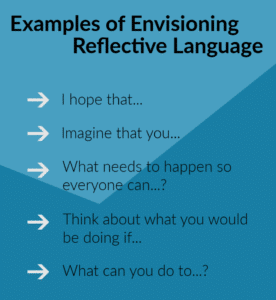
The language we use with students every day influences how they see themselves. Our words can shape students’ views of themselves years after our direct influence. Envisioning language gives children a vision of what is possible. Many of us can remember someone from our past who created a vision of possibilities for us. By using envisioning statements and/or questions, they helped us create a mental image of ourselves beyond what we perceived to know or do. Envisioning language is at the heart of reflection. It helps students see themselves achieving positive outcomes.

Along with using envisioning language, having students consider the goals they’ve set for themselves can help them see both how far they’ve come and where they want to go. Revisiting the goals they created at the beginning of the year helps students think about what they’ve learned so far and what they will learn during the rest of the year. Taking time for a reflective discussion mid-year gives students an opportunity to refocus and practice. It also sets a tone that helps students feel invested in setting and working to achieve specific goals; it also prepares them for joyful learning in the second half of the year.
When we build self-assessment into our daily schoolwork, it helps students:
Regular use of self-assessment promotes a growth mindset, and a growth mindset promotes the productive use of self-assessment. Our envisioning language keeps the classroom tone tilted toward growth. When we use words that reinforce and inspire, we send a clear message that learning is a process and our classroom is a safe place to learn and grow.
Written by Ramona McCullough, Responsive Classroom Consulting Teacher, and Educational Consultant and Coach